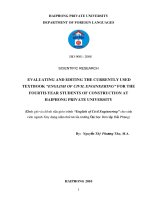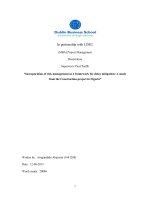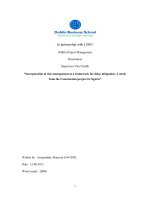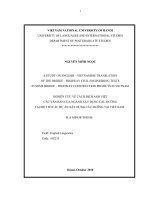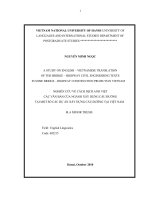the fulbright university vietnam fuv construction project
Bạn đang xem bản rút gọn của tài liệu. Xem và tải ngay bản đầy đủ của tài liệu tại đây (2.42 MB, 33 trang )
<span class="text_page_counter">Trang 2</span><div class="page_container" data-page="2">
2
TABLE OF CONTENTS
1. INTRODUCTION OF THE PROJECT ... 3
1.1. Context leading to the project ... 4
1.2. Challenges facing the project ... 4
5.1. Define project calendar ... 22
5.2. Estimate total project duration ... 26
6. PROJECT COST MANAGEMENT ... 26
6.1. Indicators reflecting the cost management performance of the project ... 26
6.2. Estimate Costs associated with each task ... 27
6.3. The ways to manage costs... 27
7. RISK MANAGEMENT... 27
7.1. Identify risks ... 27
7.2. Evaluate the identified risks (e.g., impact, possibility) ... 27
7.3. Risk map ……….30
7.4. Economic scenarios that may affect the sustainability of the project ………30
8. RECOMMENDATIONS AND CONCLUSIONS ... 27
9. REFERENCES ... 28
</div><span class="text_page_counter">Trang 3</span><div class="page_container" data-page="3">3
THE FULBRIGHT UNIVERSITY VIETNAM (FUV) CONSTRUCTION PROJECT
1. INTRODUCTION OF THE PROJECT
The Fulbright University Vietnam (FUV) Construction Project aims to establish a world-class educational institution in Ho Chi Minh City. Faced with challenges in land acquisition, regulatory navigation, and logistical coordination, the project endeavors to create a modern campus meeting international standards. Supported by funding from diverse sources, FUV strives to bridge cultural considerations, overcome infrastructure challenges, and achieve a sustainable and impactful presence in Vietnamese higher education. Ton Dat Tien, Tan Phu Ward,
Table 1: Profile of the project owner 1.1. Context leading to the project
- Launched in 2016, the Fulbright University Vietnam (FUV) initiative is a private project located in Ho Chi Minh City. It secured funding from the Fulbright Economics Teaching Program (FETP), affiliated with Harvard University, with a primary focus on enhancing economics education in Vietnam.
</div><span class="text_page_counter">Trang 4</span><div class="page_container" data-page="4">4
- FETP gained acclaim for its rigorous curriculum and successful graduates.
Recognizing this success, the Vietnamese government, in collaboration with the U.S. Department of State, granted FUV a license in 2013 to operate as an independent, nonprofit university.
- FUV received substantial financial backing from the U.S. government, U.S. donors, and Vietnamese organizations. The construction of FUV's campus is a pivotal aspect, aiming to provide a cutting-edge learning environment for both students and faculty. 1.2. Challenges facing the project
The construction project of Fulbright University Vietnam (FUV) is confronted with various challenges, including:
- Land Acquisition: Securing suitable land for the campus that meets size, accessibility, and infrastructure requirements is a complex and time-consuming process due to limited availability and competing land-use demands.
- Regulatory and Legal Hurdles: Navigating Vietnam's regulatory framework presents challenges in obtaining permits and approvals, potentially causing delays or uncertainties for a large-scale international project like FUV. - Construction Logistics: Managing stakeholders, coordinating logistics, and
ensuring timely delivery of materials, labor, and expertise pose challenges. Availability of skilled local labor may be a limiting factor.
- Funding and Financial Sustainability: Securing sufficient funding for construction and ensuring long-term financial sustainability require effective fundraising strategies and ongoing financial management.
- Cultural and Language Considerations: Adapting to local customs while maintaining international standards necessitates effective communication and understanding between the university and the local community.
- Infrastructure and Utilities: Developing a modern campus requires reliable access to infrastructure and utilities, posing challenges in regions with limited or inadequate existing infrastructure.
- Project Management: Coordinating a complex construction project requires effective project management practices for timely execution, quality control, and cost management.
</div><span class="text_page_counter">Trang 5</span><div class="page_container" data-page="5">5
- Weather Concerns: Unforeseen weather problems, such as storms and fires, can have a direct impact on the project, requiring contingency plans and adaptability.
- Delayed Payments: Managing timely payments to workers, suppliers, and contractors is crucial for project continuity, and delayed payments can lead to challenges in cash flow management.
1.3. Objectives of project
The Fulbright University Vietnam (FUV) project encompasses several key objectives, including:
- Establishing a comprehensive facility complex for Fulbright University that upholds high educational standards, aligns with international benchmarks, and addresses the specific learning requirements of students in Vietnam. - Creating a contemporary, comfortable, and secure learning and teaching
environment for both students and faculty, fostering an atmosphere conducive
Fulbright University Vietnam (FUV) is situated at 105 Ton Dat Tien, Tan Phong Quarter, Tan Phu Ward, District 7, Ho Chi Minh City, Vietnam.
</div><span class="text_page_counter">Trang 6</span><div class="page_container" data-page="6">Figure 1. Joint venture
Figure 2. Project WBS & Chart of Accounts
</div><span class="text_page_counter">Trang 9</span><div class="page_container" data-page="9">the laws of the area and the meet their living and family needs
</div><span class="text_page_counter">Trang 11</span><div class="page_container" data-page="11">11 they have good
skills and experience.
the project and respect the law.
Supervisors <sup>Receive a salary </sup>
</div><span class="text_page_counter">Trang 13</span><div class="page_container" data-page="13">and Sales Rep
+ Have the right that their works are carried out
</div><span class="text_page_counter">Trang 16</span><div class="page_container" data-page="16">scope, cost, dul
</div><span class="text_page_counter">Trang 18</span><div class="page_container" data-page="18">Table 3: Task of project
4.2. The deliveries of project
Task number WBS Task name Deliveries
Permit and approvals
Initiation <sup>Permit and approvals </sup>
factors
Identify the key elements of the project (purpose, importance, benefits) to present and plan the project with partners
</div><span class="text_page_counter">Trang 19</span><div class="page_container" data-page="19">development <sup>Draft proposal </sup>
and approval
A written proposal, a presentation or a slide show summarizing the proposal. Then wait for scope, cost, dule
Set goals that are relevant to the project; Prepare cost estimates and scope of work
FUV2.2 Construction survey Inspecting and evaluating construction sites for optimal and effective construction planning
</div><span class="text_page_counter">Trang 20</span><div class="page_container" data-page="20">20
FUV2.3 Making a feasibility report
Prepare detailed projec feasibility reports (plan design, timeline, scope
FUV3.1 Land clearance The entire project's lan area must be finalized for ground clearance to be ready for investmen with concrete, iron, .. The foundation serves the function of providing ground for the construction of auxiliary structures.
</div><span class="text_page_counter">Trang 21</span><div class="page_container" data-page="21">meets the criteria, it is necessary to modify the work as required.
and approval
Submit a stakeholder report for approval to confirm that the standard factory has been built.
arrangement
Rearrange equipment and furniture in the correct area according to each function in the
</div><span class="text_page_counter">Trang 22</span><div class="page_container" data-page="22">22
over the project.
Table 4: Deliveries of project
4.3. WBS of tasks
Figure 3: (WBS) of the project
5. TIME MANAGEMENT
5.1. Define project calendar
Task Task name Duratio n
Precedents ES EF LS LF <sup>Floating </sup> Time <sup> </sup>
</div><span class="text_page_counter">Trang 25</span><div class="page_container" data-page="25">Table 6: Time management
Table 7: Total time of this project 5.2. Estimate total project duration
Based on the table "Time Management", we can estimate the total project duration is 64 weeks and the PERT chart as follows:
</div><span class="text_page_counter">Trang 26</span><div class="page_container" data-page="26">26
Figure 4: PERT chart of the project's duration
6. PROJECT COST MANAGEMENT
6.1. Indicators reflecting the cost management performance of the project ● Budget Variance: This indicator measures the difference between the planned
budget and the actual costs incurred. A positive variance indicates that the project is under budget, while a negative variance suggests that costs have exceeded the budget.
● Cost Performance Index (CPI): A CPI is a ratio that compares the value of work accomplished to the actual costs incurred. It provides insights into cost efficiency. A CPI value greater than 1 indicates that the project is performing well in terms of cost management, while a value less than 1 indicates cost overruns.
● Schedule Performance Index (SPI): SPI measures the ratio of work accomplished to the work planned for a given period. While SPI primarily reflects schedule performance, it can indirectly impact cost management. Delays or accelerations in the project schedule can affect costs, and SPI can provide insights into such effects.
● Earned Value (EV): EV is a technique that integrates cost, schedule, and work accomplished to assess project performance. It compares the budgeted cost of work performed with the actual cost of work performed, providing a holistic view of cost management performance.
● Cost Variance (CV): CV calculates the difference between the earned value (EV) and the actual cost (AC). A positive CV indicates that the project is under budget, while a negative CV suggests cost overruns.
● Cost Estimation Accuracy: Assessing the accuracy of cost estimates by comparing them to the actual costs incurred can indicate the effectiveness of cost management practices. A lower variance between estimated and actual costs suggests better cost estimation.
These indicators provide a comprehensive overview of the cost management performance of the FUV construction project. By monitoring these indicators
</div><span class="text_page_counter">Trang 27</span><div class="page_container" data-page="27">27
throughout the project's lifecycle, project managers can identify potential cost overruns, take corrective actions, and ensure effective cost control.
6.2. Estimate Costs associated with each task
Table 8 : Cost management 6.3. The ways to manage costs
To manage costs in the Fulbright University Vietnam (FUV) construction project:
● Estimate costs accurately and create a comprehensive budget. ● Implement a cost tracking system to monitor expenses in real-time. ● Use value engineering to find cost-effective design and construction
options.
● Negotiate competitive contracts and pricing with vendors. ● Plan for contingencies by including a contingency budget. ● Establish a change control process to manage scope changes. ● Optimize resource allocation to prevent downtime and maximize
productivity.
● Conduct regular cost reviews to identify cost-saving opportunities. ● Manage risks and implement mitigation strategies.
● Maintain continuous monitoring and reporting of costs to stakeholders By implementing these strategies and maintaining a proactive approach to cost management, the Fulbright University Vietnam (FUV) construction project can effectively control and optimize its costs.
</div><span class="text_page_counter">Trang 28</span><div class="page_container" data-page="28">28 ● Worker's accidents ● Schedule Delay ● Material cost increase ● Exchange Rates Change
</div><span class="text_page_counter">Trang 29</span><div class="page_container" data-page="29">29
7.2. Evaluate the identified risks (e.g., impact, possibility)
Table 9: Risk managament
</div><span class="text_page_counter">Trang 30</span><div class="page_container" data-page="30">30 7.3. Risks map
Figure 5 : Risk map
7.4. Economic scenarios that may affect the sustainability of the project The following economic scenarios could have an impact on the project's sustainability:
● Economic Growth and Interest Rates: Experts are cautiously optimistic about economic growth in 2024, with expectations of more consistent and accelerating growth throughout the year . However, this is dependent on the assumption that the Federal Reserve is done raising interest rates. If interest rates continue to rise, it could increase borrowing costs for construction projects and potentially impact their feasibility and sustainability.
● Labor Issues: Labor shortages and strikes can disrupt construction projects and lead to delays and increased costs. For example, the recent United Auto Workers strike had an impact on GDP in the third and fourth quarters of the previous year . If labor issues persist in 2024, it could affect the sustainability of construction projects by causing delays and increasing costs.
● Geopolitical Risks: Tensions in regions like Russia, Ukraine, and the Middle East can create uncertainties and risks for the global economy. While experts forecast that tensions will start to ease in the coming months, geopolitical risks remain intense . These risks can affect the stability of financial markets, access to resources, and overall economic conditions, potentially impacting the sustainability of construction projects.
● Construction Starts and Market Demand: The overall value of construction starts is expected to rise by 7% in 2024, following a 1%
</div><span class="text_page_counter">Trang 31</span><div class="page_container" data-page="31">31
increase in 2023 . This indicates a positive outlook for the construction industry. However, the sustainability of construction projects depends on market demand and the ability to secure contracts and funding. Changes in market conditions and demand can impact the viability and sustainability of construction projects.
8. RECOMMENDATIONS AND CONCLUSIONS
8.1. Discuss the topics:
The Fulbright University Vietnam (FUV) Construction Project, initiated in September 2019 and scheduled for completion by August 2025, is a substantial undertaking to establish a premier educational institution in Ho Chi Minh City. Encompassing 50,000 square meters, the project prioritizes the construction of modern classrooms, a vibrant campus, a well-equipped library, a spacious canteen, efficient power sources, and robust security measures. This comprehensive approach underscores FUV's commitment to providing a top-notch learning environment, fostering academic excellence, and contributing to the educational landscape of Vietnam. 8.2. Recommendations:
Recommendations for the Fulbright University Vietnam (FUV) Construction Project include fostering stakeholder engagement for diverse perspectives, prioritizing sustainable and technologically advanced infrastructure, ensuring accessibility, implementing robust safety measures, integrating with the local community, and maintaining financial transparency. Continuous monitoring, post-construction planning, and flexibility in design will contribute to the project's success, creating a modern, inclusive, and forward-thinking educational institution in Ho Chi Minh City.
8.3. Conclusion
The comprehensive analysis presented establishes the Fulbright University Vietnam (FUV) Construction Project as not only viable but also poised to be a significant attraction for students upon completion. The proven feasibility, coupled with the anticipated state-of-the-art facilities, suggests that the project is positioned to yield
</div><span class="text_page_counter">Trang 32</span><div class="page_container" data-page="32">32
remarkable returns. The completion of FUV is expected to instill confidence among investors, highlighting its potential to become a thriving educational institution in Ho Chi Minh City and contribute significantly to the region's academic landscape.
9. REFERENCES
1. Project Monitoring and Control Techniques (2019). Available at: (Accessed: 1 June 2023).
2. Project Monitoring and Control Best Practices (2023). Available at: (Accessed: 1 June 2023).
3. 10 elements of IT projects you should monitor regularly | Start Nearshoring (2018). Available at: - -projects-you-of it should-monitor-regularly/ (Accessed: 1 June 2023).
4. 28 Important Project Management KPIs (& How To Track Them) | ClearPoint Strategy (2023). Available at: (Accessed: 1 June 2023).
<i>5. DFC Commits $37 Million for Fulbright University Vietnam’s New Campus in Ho </i>
Chi Minh City, Expanding Economic Opportunity | DFC. (2021, October 29). DFC Commits $37 Million for Fulbright University Vietnam’s New Campus in Ho Chi Minh City, Expanding Economic Opportunity | DFC.
6. Zevin, A. (2023, November 22). 2024 FORECAST: Non-building, Manufacturing to Lead the Way. 2024 FORECAST: Non-building, Manufacturing to Lead the Way | Engineering News-Record.
</div>